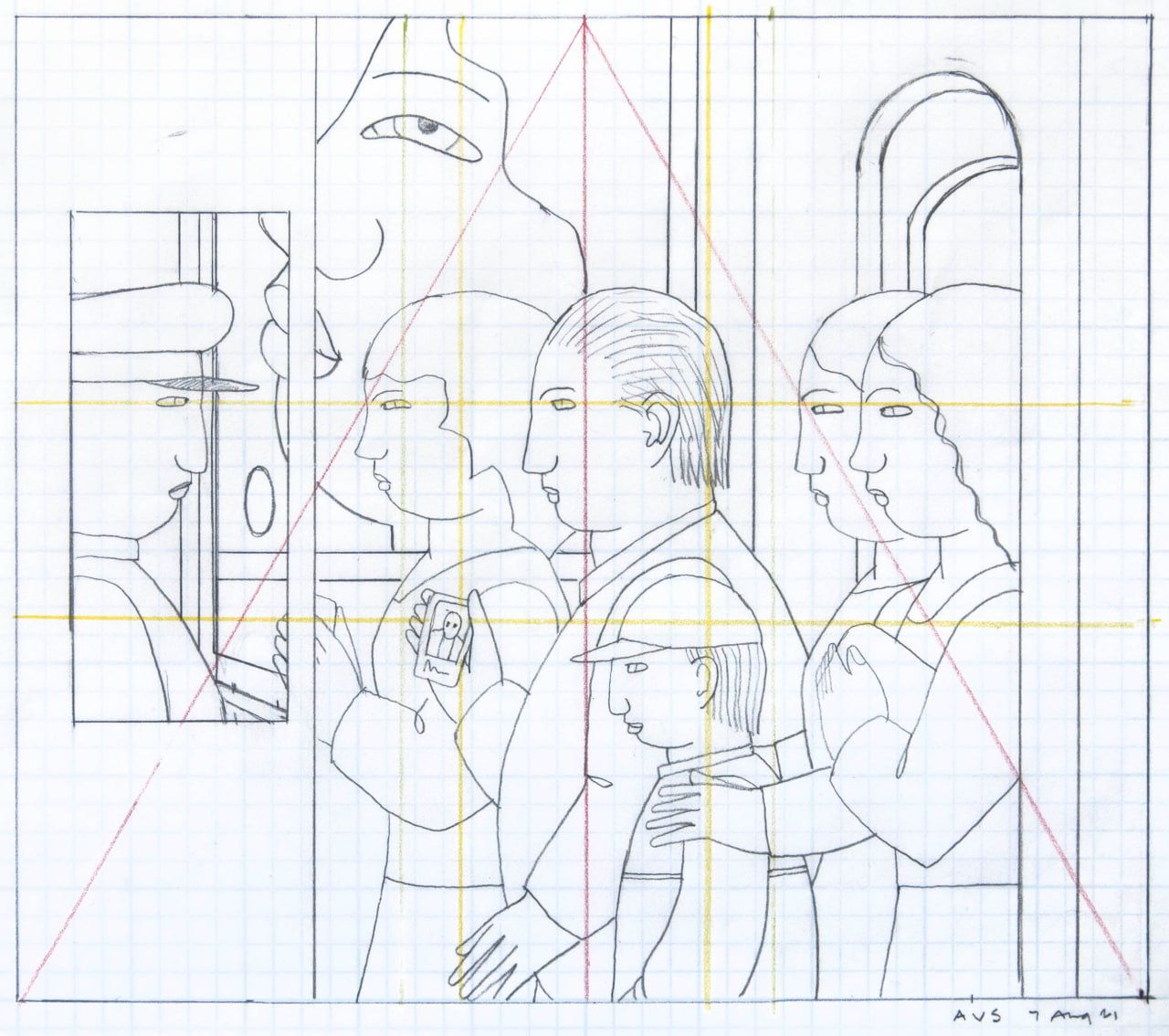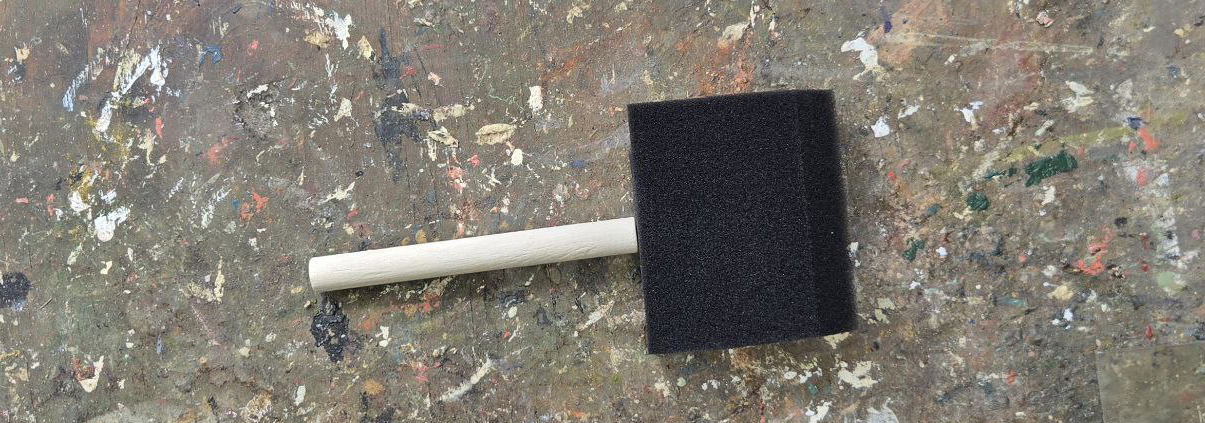NOTE: This page is actively being edited and written
Ideation
Much of the concept work for my compositions come from studies of composition described later in my drawing process, however all my work does have a narrative component. These often start as simplified sketches using only a few lines which hint at a narrative. These sketches can come from dreams, and experiences or some just appear.
Composition
Iterations
I usually do a number of drawings to work out the composition and finally the size. I work on vellum paper - not as thin as tracing paper, but it is translucent enough so it can function as such. As I develop the drawing, I'll retrace parts of the drawing that I like, make changes, etc..
Ratios

The red, green, and yellow lines visible in the above drawing delineate various sections that I find useful and always put into at least one of the drawings for a particular composition. The red divides the picture into halves with their related diagonals, the green into thirds, and the yellow marks out the "golden sections" and their diagonals. While I don't adhere religiously to any mathematical system, I find the last one especially interesting.
The "golden section" is based on a ratio that was first described ca. 300 BC by Euclid. It has been found in nature and has been used by many artists and architects in a search for harmony and balance. The same ratio exists between successive Fibonacci numbers. Now commonly called PHI (φ), the ratio is 1.618. In the drawing above, the horizontal yellow line just below the woman's lips is placed at .618th of the height and it gave me two diagonals. When I was looking to place the woman's arm, it seemed to work best when its angle followed one of the diagonals. I'm amused by how often lines and placements in a composition feel right when there is a relationship to φ.
Transfer Process (Pastel Tone)
When I have my final drawing - again on vellum - it will be the same size as the canvas awaiting it. I'll cover the back of the drawing with pastel - creating what I call my "transfer drawing" - and place it over the blank canvas. Then I go over all the lines with a pencil. The pastel acts like a "carbon paper" and the pressure of the pencil transfers a pastel line to the canvas. (I use pastel rather than carbon paper or a dressmakers transfer sheet, because then I know the pastel is chemically safe and will not possibly cause a future technical problem.)
Many drawings have this pastel tone, it's important to note that this is not a aesthetic choice, it is always a utilitarian part of the development of a final painting and it represents the drawing that was selected to be transfered to the canvas.
The transfer process producess faint temporary pastel lines on the canvas which I trace with a pencil otherwise, the pastel will brush away.
Oil Paintings
Paint
Base Medium
I've been using a painting medium that is composed of 50% stand oil and 50% damar varnish with some turpentine added in small amounts if needed to adjust the fluidity of the medium. This solution is mixed with the paint that comes out of the tube to give it the desired consistency.
Stand oil is a form of linseed oil that has been heated for many hours, the process thickens and darkens it a bit and gives it a consistency like honey. Stand oil will not yellow over time as much as regular linseed oil and has more strength and flexibility than regular linseed oil.
Damar Varnish is made from the resin of a family of tropical gum trees. The resin is dissolved in turpentine and can be used by itself as a final varnish, or in solution with stand oil or linseed oil as a painting medium. As a medium, it adds some brightness to the color and aids in quickening the drying time.
I've used this combination for decades, and I settled on it after a lot of research and experimentation. In books about painting techniques, both historical and modern, there are many opinions on what is the best medium, and some artists believe that the quality achieved in the past was due to special formulas and recipes.
Base Medium
[header {"level":1,"content":"Oil Paintings}]
Linework and Outlines
to do.
General Rendering
to do.
Hair Rendering
to do.
Ethereal Concepts
to do
Brushes

I use brushes intended for watercolor and they range in size from 000 for fine detail work to a #5 or 6, sometimes larger. Watercolor brushes are softer in texture than the bristly brushes usually used for oil painting, which helps me achieve a smoother paint surface.
Embeds
Signature
For many years now, I've signed my oil paintings, generally with my initials 'AVS' on the front of the painting, on the backing of the painting I also sign with my full name and date. For the front signature I want it to be minimally invasive and on occasion will work them into elements of the painting itself, like newspapers or cards. In the past I have dated a few pieces as well on the front.
Post Processes
When an oil painting is finished, I finalize it with a few materials, some of this is for protection and longevity of the vibrance of the piece but some are still in the realm of painting and visually enhancing the artwork.
Glaze
I use a spot glazing technique, using a 5 or 6 brush. This method involves delicately applying a glaze that I then feather and soften with my finger, primarily targeting areas of skin and hair. This technique subtly emulates the phenomenon of subsurface scattering—a natural occurrence where light penetrates surfaces like skin, scattering internally to absorb and reflect rich, deep colors. The glaze recreates this by addng a layer of specular nuance and warmth that differs from the base painted rendering.
Varnish
I use a large foam brush to evenly coat the surface with retouch varnish, which is thinner than traditional varnish, and can be applied shortly after the paint surface becomes dry. Varnish, in painting, serves as a protector and beautifier and it's important to note it's transience, it can be safetly removed and reapplied in the far future as part of a restoration process.
As oil paint dries, there can be contrast in the sheen and vibrance of the surface due to variance in the base mixture of the paints and inherent properties of the pigments used. Varnish unifies the colors and textures. It also acts as a shield against atmospheric elements, crucial for the artwork's longevity and preservation.

Shipping
That done, the painting is photographed, installed into its frame, and ready to leave the studio.
- varnish, gloss signature
- signature positions
# SIGNATURE
For many years now, I've signed my oil paintings with my initials 'AVS' and have not dated them. The full name and date are provided on the backing of the painting.
I want my signature to be minimally invasive, not visually intrusive to the experience of viewing the painting. The initials are normally placed in a way to be as subtle as possible.
# STAGING
stretching the canvas/linen would be attaching it to the wood stretchers. Mounting would be that the painting is on a piece of canvas/linen that has not been attached to anything, so it gets treated more like a drawing when it goes to the frame shop. Mine will get pasted to a supporting board, using a press, to give it a bit of stiffness/support, and then it is farmed the same as a drawing would be, with a matt, etc. at least thats how I do it.

